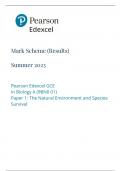Species Study guides, Class notes & Summaries
Looking for the best study guides, study notes and summaries about Species? On this page you'll find 19010 study documents about Species.
Popular textbooks 'Species' · Show all (4) Hide
All books 4 HideAll 19.010 results
Sort by
 Popular
Popular
-
EED2601 Assignment 3 2023 (ANSWERS)
- Other • 9 pages • 2023
-
- $2.70
- 52x sold
- + learn more
EED2601 Assignment 3 2023 (ANSWERS) ACTIVITY 1 1.1 Environmental education (EE) processes need to take into consideration the history and context behind certain environmental issues and their implications for communities and their lived context. 1.1.1 State any three environmental issues faced by the South African citizens. (3) 1.1.2 Discuss the implications of the above-mentioned environmental challenges. (6) 1.1.3 Name at least one softwood tree species. (1) ACTIVITY 2 2.1 Afte...
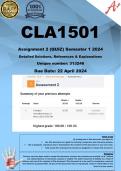 Popular
Popular
-
CLA1501 Assignment 2 (COMPLETE ANSWERS) Semester 1 2024 (313246) - DUE 22 April 2024 ;
- Exam (elaborations) • 333 pages • 2024 Popular
-
- $2.70
- 26x sold
- + learn more
CLA1501 Assignment 2 (COMPLETE ANSWERS) Semester 1 2024 (313246) - DUE 22 April 2024 ;100% TRUSTED workings, explanations and solutions. for assistance Whats-App.......0.6.7..1.7.1..1.7.3.9............ Question 1 Not yet answered Marked out of 1.00 Question 2 Not yet answered Marked out of 1.00 QUIZ Before their marriage, Nkomi and Thabang concluded an antenuptial contract which they chose not to register. After fi veyears, Nkomi institutes divorce proceedings against Thabang, arguing t...
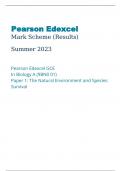
-
Pearson Edexcel Mark Scheme Summer June 2023 Pearson Edexcel GCE In Biology A 9BN0 01 Paper 1 The Natural Environment and Species Survival
- Exam (elaborations) • 28 pages • 2023
-
Available in package deal
-
- $16.99
- 2x sold
- + learn more
Pearson Edexcel Mark Scheme Summer June 2023 Pearson Edexcel GCE In Biology A 9BN0 01 Paper 1 The Natural Environment and Species Survival
PEARSON EDEXEL A LEVEL BIOLOGY A PAPER 1 2023 MARK SCHEME (9BN0/01: The Natural Environment and Species Survival)
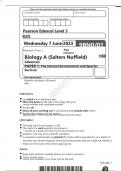
-
Pearson Edexcel Level 3 GCE Biology A (Salters Nuffield) Advanced PAPER 1 May 2023 question paper
- Exam (elaborations) • 42 pages • 2023
- Available in package deal
-
- $17.99
- 3x sold
- + learn more
Pearson Edexcel Level 3 GCE Biology A (Salters Nuffield) Advanced PAPER 1: The Natural Environment and Species Survival
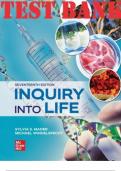
-
TEST BANK for Inquiry into Life 17th Edition by Sylvia Mader and Michael Windelspecht. Complete Chapters 1-37.
- Exam (elaborations) • 929 pages • 2023
-
- $34.15
- 10x sold
- + learn more
Inquiry into Life 17th Edition by Sylvia Mader and Michael Windelspecht. TEST BANK 1. Biology: The Study of Life Unit 1 Cell Biology 2. The Molecules of Cells 3. Cell Structure and Function 4. Me mbra ne Structure and Function 5. Cell Division 6. Metabolism: Energy and Enzymes 7. Cellular Respiration Unit 2 Plant Biology 8. Photosynthesis 9. Plant Organization and Function 10. Plant Reproduction, Growth, and Response Unit 3 Maintenance of the Human Body 11. Human Organization 12. Cardiovascular ...
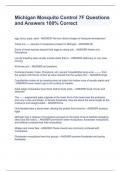
-
Michigan Mosquito Control 7F Questions and Answers 100% Correct ‘
- Exam (elaborations) • 7 pages • 2023
- Available in package deal
-
- $10.49
- 5x sold
- + learn more
Michigan Mosquito Control 7F Questions and Answers 100% Correct ‘ Michigan Mosquito Control 7F Questions and Answers 100% Correct ‘ Michigan Mosquito Control 7F Questions and Answers 100% Correct ‘egg, larva, pupa, adult - ANSWER-The four distinct stages of mosquito development There are ----- species of mosquitoes present in Michigan - ANSWER-60 Some of these species deposit their eggs on damp soil. - ANSWER-Aedes and Psorophora Larvae breeding sites usually include water th...
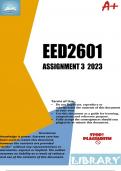
-
EED2601 Assignment 3 (COMPLETE ANSWERS) 2023 - DUE 2 August 2023
- Exam (elaborations) • 17 pages • 2023
-
Available in package deal
-
- $2.71
- 25x sold
- + learn more
EED2601 Assignment 3 (COMPLETE ANSWERS) 2023 - DUE 2 August 2023 100% TRUSTED workings, explanations and solutions. For assistance call or whatsapp us on +254 11 003 4399 . 1.1 Environmental education (EE) processes need to take into consideration the history and context behind certain environmental issues and their implications for communities and their lived context. ACTIVITY 1 1.1.1 State any three environmental issues faced by the South African citizens. (3) 1.1.2 Discuss the impl...
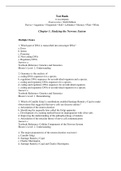
-
Neuroscience 6th Edition Test Bank by Purves | 100% Correct Answers | 34 Chapters.GUARANTEED PASS
- Exam (elaborations) • 246 pages • 2023
-
- $11.99
- 7x sold
- + learn more
Neuroscience 6th Edition Test Bank by Purves | 100% Correct Answers | 34 Chapters.VERIFIED 1. Which part of DNA is transcribed into messenger RNA? a. Exon b. Intron c. Promoter d. Non-coding DNA e. Re gulatory DNA Answer: a Textbook Reference: Genetics and Genomics Bloom’s Level: 2. Understanding 2. Genomics is the analysis of a. coding DNA sequences for a species. b. regulatory DNA sequences for an individual organism and a species. c. coding and regulatory DNA sequences for a species. d. cod...
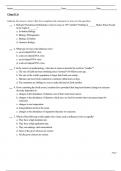
-
Test Bank for Evolution: Making Sense of Life, 3rd Edition by Douglas Emlen
- Exam (elaborations) • 268 pages • 2023
-
- $39.49
- 10x sold
- + learn more
Test Bank for Evolution: Making Sense of Life 3e 3rd Edition by Douglas Emlen, Carl Zimmer. Full Chapters test bank are included - Chapter 1 to 18 1 The Whale and the Virus: How Scientists Study Evolution 1 2 From Natural Philosophy to Darwin: A Brief History of Evolutionary Ideas 28 3 What the Rocks Say: How Geology and Paleontology Reveal the History of Life 52 4 The Tree of Life: How Biologists Use Phylogeny to Reconstruct the Deep Past 5 Raw Material: Heritable Variat...

-
EED2601 assignment 3 due 02 August 2023
- Other • 20 pages • 2023
-
- $4.04
- 6x sold
- + learn more
ACTIVITY 1 1.1 Environmental education (EE) processes need to take into consideration the history and context behind certain environmental issues and their implications for communities and their lived context. 1.1.1 State any three environmental issues faced by the South African citizens. 1.1.2 Discuss the implications of the above-mentioned environmental challenges. 1.1.3 Name at least one softwood tree species. (1) 1.1.1 Three environmental issues faced by South African c...

-
ENL1501 Assignment 1 Semester 1 2024 (Solutions)
- Other • 26 pages • 2024
-
- $2.70
- 3x sold
- + learn more
ENL1501 Assignment 1 Semester 1 2024 (Solutions) Question 1 Answer saved Marked out of 1.00 Flag question Question text How can packaging support the environment? a. By providing clear environmental information b. By using excessive materials c. By making products more expensive d. By being visually unappealing Clear my choice Question 2 Answer saved Marked out of 1.00 Flag question Question text What is the primary role of air for bioresources? a. Providing structural s...

Do you wonder why so many students wear nice clothes, have money to spare and enjoy tons of free time? Well, they sell on Stuvia! Imagine your study notes being downloaded a dozen times for $15 each. Every. Single. Day. Discover all about earning on Stuvia


